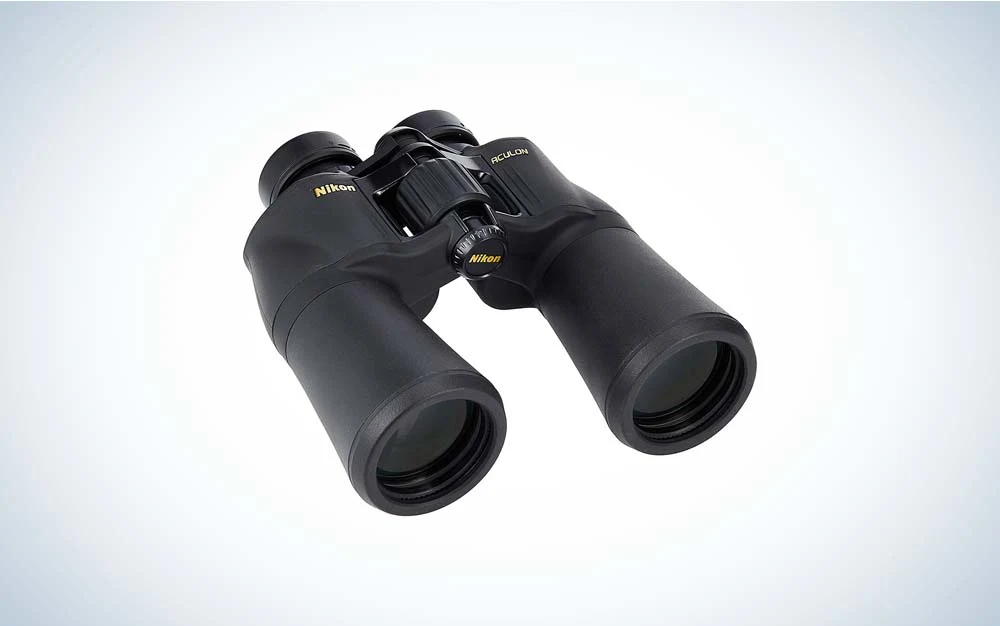We may earn revenue from the products available on this page and participate in affiliate programs. Learn more ›
_
People who claim you need high-end optics for hunting are forever saying, “Look at the western big-game guides. They haven’t got a pot to piss in, and yet they’ve got $2,000 binoculars hanging around their necks.” Well, yes, some do. But plenty don’t. My Colorado mule deer guide last year had Vortex Diamondback HDs, which go for about $270. My elk guide a few years earlier had porro-prism Bushnell Legacys, about $80. I asked him why he liked them: “What’s not to like?” he said. “They’re cheap, and they get the job done.” Hard to argue with that.
If you can afford to buy the best glass, go for it. You won’t be sorry. Top-shelf binos are awesome, in the true sense of the world. But do you need them? No way.
First, the vast majority of hunters don’t need to count tines at 1,000 yards. Second, the quality of affordable binoculars has improved so much that as a purely practical matter—when it comes down to simply putting game on the ground—there’s not a whole lot a good cheap binocular can’t do that a high-end one can.
We spent days testing optics to find the best cheap binoculars out there, from top brands like Vortex, Bushnell, and Maven. The binos below are all legit hunting tools, all costing $350 or less, and some much less.
The Best Cheap Binoculars
Under $150
Under $250
Under $300
Under $450
How We Tested Binoculars
I’ve put every one of these binoculars through its paces, starting with a resolution test, using the 1951 USAF Optical Resolution Chart both in sunlight and deep shade. Then I compared features and evaluated image quality, ergonomics, and low-light performance.
I tested weather-resistance in two stages: I sprayed the binos down thoroughly with a hose and put them in the freezer for 15 minutes to simulate a soaking rain followed by dropping temps. Then, to really test their limits, I submersed each in water for an hour and then popped them in the deep freeze for another hour. Not all of them survived it, but, it’s worth noting, all do come with a lifetime warranty.
In the end, when the days-long testing was done, I came to roughly the same conclusion about the best cheap binoculars below as my elk guide did about his favorite El Cheapos: They’ll get the job done.
Nikon Aculon A211 10×50

Specs
Weight: 31.7 ounces
Size: 7×7.8 inches
FOV at 1000 yards 341 feet
Multicoated ECO Glass lenses
Non-phase-coated porro prism
Not fog- or waterproof (comes in 10 other configurations)
There are three key things you need to know about the Nikon Aculon. First, it had the best resolution of any binocular here. Remarkably, it resolved detail every bit as well as my favorite $1,000 bino. Second, it is not waterproof. Although it survived my spray-down test, its barrels quickly filled with water when submerged. Third, although not heavy, it is somewhat large and bulky. All of this leads to one conclusion: This is a truck binocular. Build quality is nothing special, but the diopter adjustment is nice and stiff, which is what you want with a non-locking dial to keep it from inadvertently changing on you.
The image has a fair amount of distortion and flaring around the edges, but that won’t keep you from pulling fine detail from the middle of the field. With an exit pupil of 5, low-light performance is quite good. I tested all 10-power models in this test for an apples-to-apples comparison, but if it were me, I would get the 16×50 Aculon and keep them on the dash of the truck for spotting animals and counting tines from way off. At this price, you could get one for every vehicle you own.
Vortex Raptor 10×32
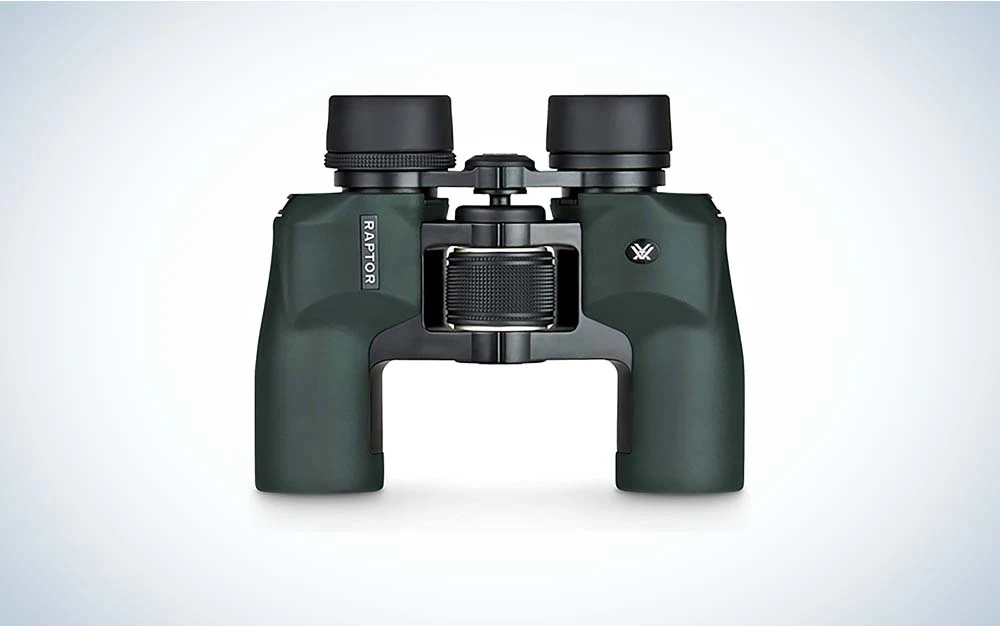
Specs
Weight: 17.6 ounces
Size: 4.5×5.7 inches
FOV at 1000 yards: 339 feet
Fully multicoated lenses
Non-phase-coated porro prism
Waterproof and fogproof (also comes in 8×32)
The Vortex Raptor is very much like the Yosemite in size, weight, and purpose. Its resolution was just a tick below the Yosemite, but image quality was as good if not slightly better, with fairly little distortion around the edges. Where the Raptor stands out is build-quality. It’s the best of the porros. With the exception of a slightly loose, non-locking diopter dial, everything feels smooth and positive and well-finished.
The Raptor sailed through the spray-down test, with water beading off the glass as well as almost any model. But ultimately, it failed the soaking-and-freezing portion, collecting moisture in both barrels that rendered them unusable. That said, I believe they would be fine under normal conditions. (I assume you’re not planning to submerse yours for an hour.) I also suspect that moisture in the barrels would be covered under the company’s excellent warranty.
Leupold BX-2 Alpine 10×42
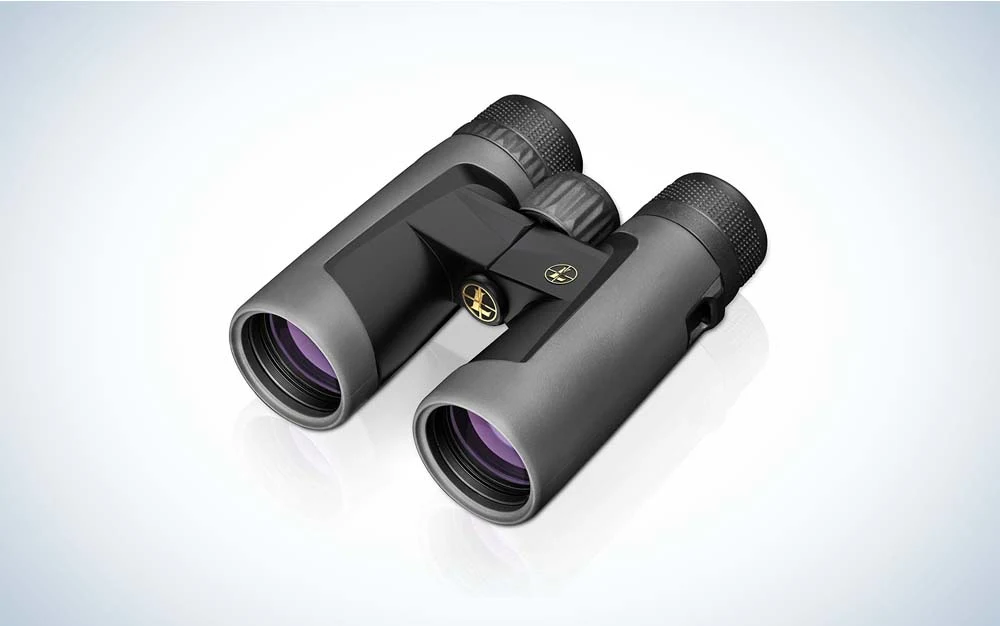
Specs
Weight: 28 ounces
Size: 6.2×5 inches
FOV at 1000 yards: 367.5 feet
Fully multicoated lenses
Phase-coated roof prism
Waterproof and fogproof (comes in four configurations)
The Leupold BX-2 Alpine puts everything together quite well. Resolution was on par with most of the other roof prisms here, while image quality and low-light performance were a little above average. It has the largest field of view, which helps in what optics geeks call “feeling of immersion”—like you’re almost inside the image. Ergonomics stood out: The Alpine feels good in the hand; the focus wheel is easy and smooth to turn; and the eye-cup adjustments are just right—smooth but with enough resistance that you can set them at the default stops or anywhere in between and they’ll stay there.
They also did well in the weather test. They beaded water nicely, and even after coming right out of the freezer and into warmer temps, they provided a good-enough picture to spot critters. The non-locking diopter is a tad too loose, and the finish is a little slick—both minor quibbles. This is a very solid all-around hunting binocular for the price, and it comes with a very nice soft case.
Bushnell Prime 10×42
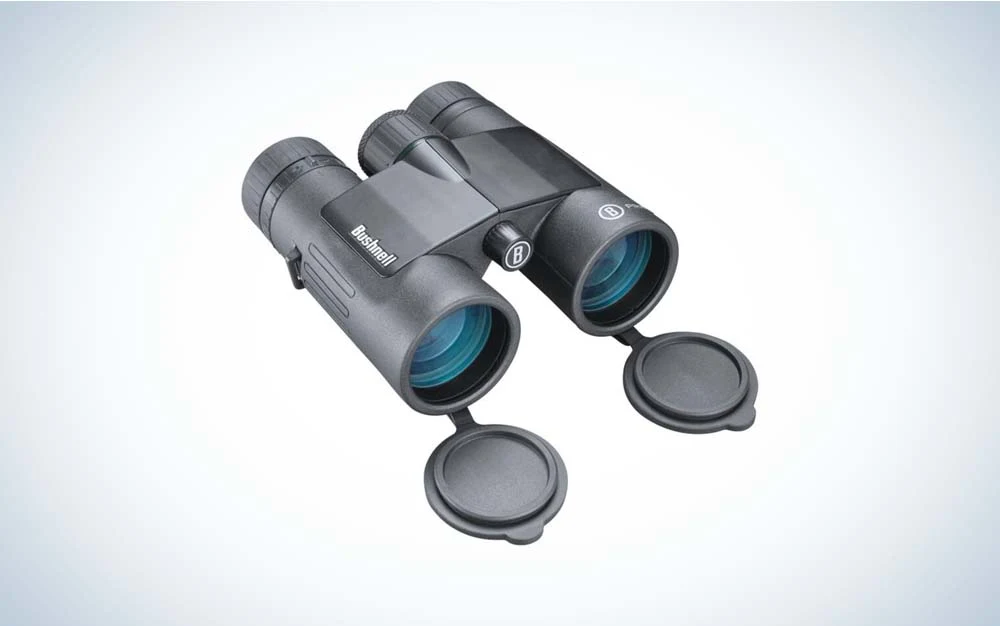
Specs
Weight: 23.3 ounces
Size: 5.2×5 inches
FOV at 1000 yards: 305 feet
Fully multicoated lenses
Non-phase-coated roof prism
Waterproof and fogproof with EXO Barrier (comes in six configurations)
With the Prime, it seems like Bushnell set out to make a rock-bottom-priced roof-prism that can still stand up to hard use afield—and they pulled it off. Although image quality is lacking (you feel a little like you’re looking down a tunnel with these, and there is noticeable blurring around the edges), the Prime’s resolution scores were decent. The adjustments are rough, and the binocular feels a tad chintzy, but—and this is both surprising and important—the Prime, featuring the company’s excellent EXO Barrier and IPX7 waterproof construction, tied for second-best overall in the weather test.
At no point in the soaking or freezing did it fail to provide a useable image, which is very impressive at this price. The Prime is also the most compact of the full-size binos here, and the lens-cover design is better than most. If you’re on a very tight budget and you want roof-prims, these will do the job for you.
Nikon Monarch 5 10×42
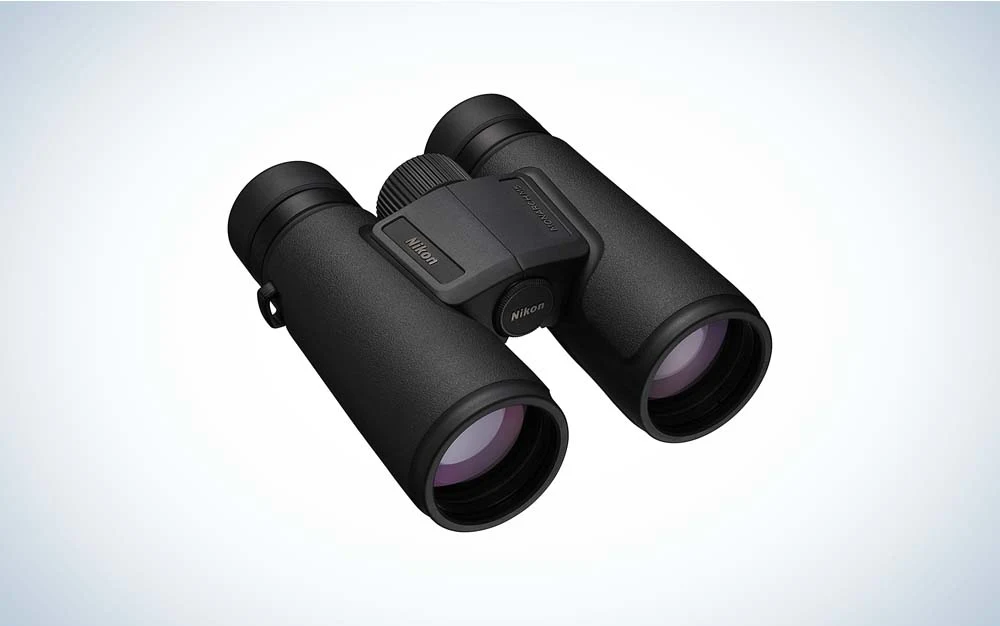
Specs
Weight: 21.6 ounces
Size: 5.7×5.1 inches
FOV at 1000 yards: 288 feet
Fully multicoated lenses, ED Glass
Phase-and-dielectric coated roof prism
Waterproof and fogproof (comes in four configurations)
With higher-end extra-low-dispersion glass and both phase-correction and dielectric coatings on the prism, the Nikon Monarch 5 delivers a brighter image with less chromatic aberration compared to most here. Most impressive, it finished first in resolution among the roof-prism models. The FOV is relatively narrow, and there is some flaring at the edges of the image, but the Monarch 5 stands out ergonomically. There’s a nice tacky feel to the rubber coating; the eye-cup adjustments are smooth with positive stops; the diopter doesn’t lock but is stiff enough that it won’t move; and the lens-cover design is rock-solid.
The Monarch 5 finished middle-of-the-pack in the weather test, fogging and icing over at points, but it survived with no ill-effects. Bottom line: If resolving fine details—like antlers among branches and brush—is what matters most to you, you can’t go wrong here.
Vortex Diamondback HD 10×42

Specs
Weight: 21.3 ounces
Size: 5.7×5.1 inches
FOV at 1000 yards: 300 feet
Fully multicoated lenses
Dielectric-coated roof prism
Waterproof and fogproof (comes in eight configurations)
Of all the low-cost binos out there, this is the one I’ve most often seen in the hands of western guides—which is a little curious on one hand, because the Vortex Diamondback HD finished near the bottom of the pack for resolution. On the other hand, it’s the lightest roof-prism model in the test and has a reputation for toughness. Image quality is on par with most others, showing some blurring around the edges. Ergonomics are solid; all the adjustments are fairly smooth and although the diopter doesn’t lock, it has adequate resistance.
The worst downpour is not going to keep you from spotting critters with the Diamondback, which scored at the very top for shedding water. It had a little more trouble with the deep freeze, but ultimately passed the worst of the weather test. All told, the Diamondback HD is lightweight and rugged, and the fact that western guides cling to them should mean something. They come with a GlassPak soft case and harness, which is very nice.
Vanguard Endeavor ED II 10×42
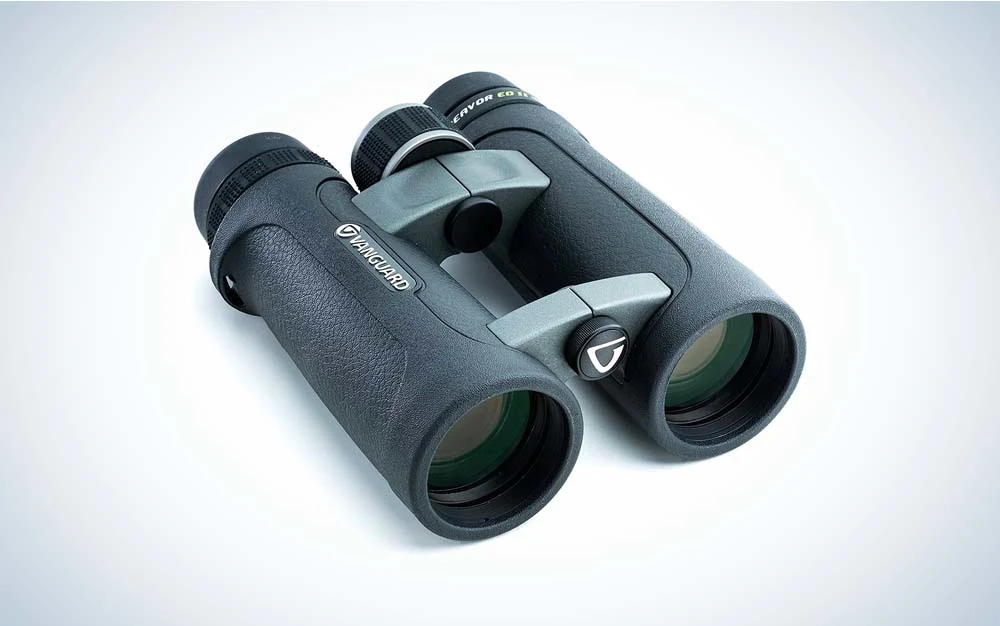
Specs
Weight: 27.2 ounces
Size: 6×5 inches
FOV at 1000 yards: 340 feet
Fully multicoated lenses
Hoya ED glass
Phase-coated roof prism
Waterproof and fogproof (also comes in 8×42 and 8×32)
The Vanguard Endeavor ED II has the finish and the feel of a higher-end binocular—because that’s what it is. Its original retail price was $499, but the company has dropped that by $100. The textured rubber coating is attractive and feels great in hand. The open-bridge construction is comfortable, and overall ergonomics are top of this class. Eye-cup adjustments are tight and positive; the focus wheel is easy and smooth; and the diopter dial locks in place. With higher-end ED glass, the Endeavor provides a nice, big picture with high-contrast colors, decent resolution, and comparatively low blurring at the edges.
The ED II aced the weather test, delivering a useable image in every phase of the evaluation. On the downside, there is noticeable chromatic aberration, although that does not bother everyone, and the focus wheel is not quite as precise as it should be. In the end, they cost a bit more than the others here, but in several ways, you get a bit more.
Meopta Optika HD
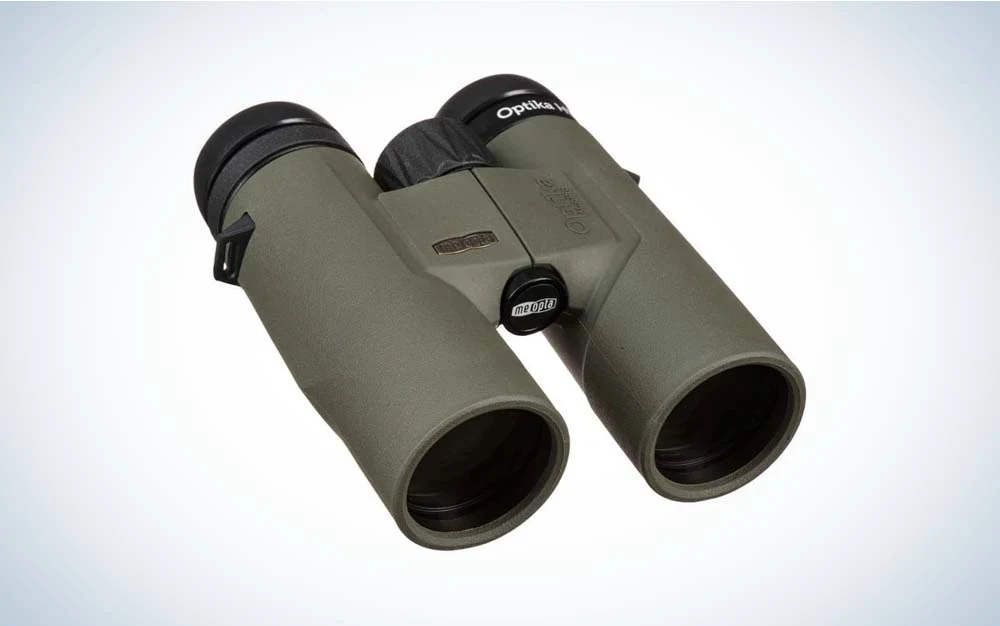
Specs
Weight: 22.9 ounces
Size: 5.4×5 inches
FOV at 1000 yards: 314 feet
Fully multicoated lenses, ED glass
Phase-and-dielectric-coated roof prism
Waterproof and fogproof, with Hydrophobic coating (also comes in 8×42)
This Czech company is known for producing optics that perform well above their price, and the Meopta Optika HD is no exception. Compact and well-balanced, the Optika scored near the top in build quality and ergonomics. The rubber coating has a nice grippy feel, the focus wheel is smooth and precise, and while the diopter does not lock, it’s good and tight. Resolution was only on par with most others here, but image quality was better—bright, with high-contrast colors and little blurring at the edges.
Only one binocular fared better in the weather test. In other words, no amount of water or freezing temperatures or temperature changes will sideline this binocular, even briefly. Honestly, it’s hard to find anything to quibble over with the Optika, especially at this price. I suppose it’s a little plain-looking. Otherwise, it’s a great value.
Bushnell Trophy Xtreme 10×42
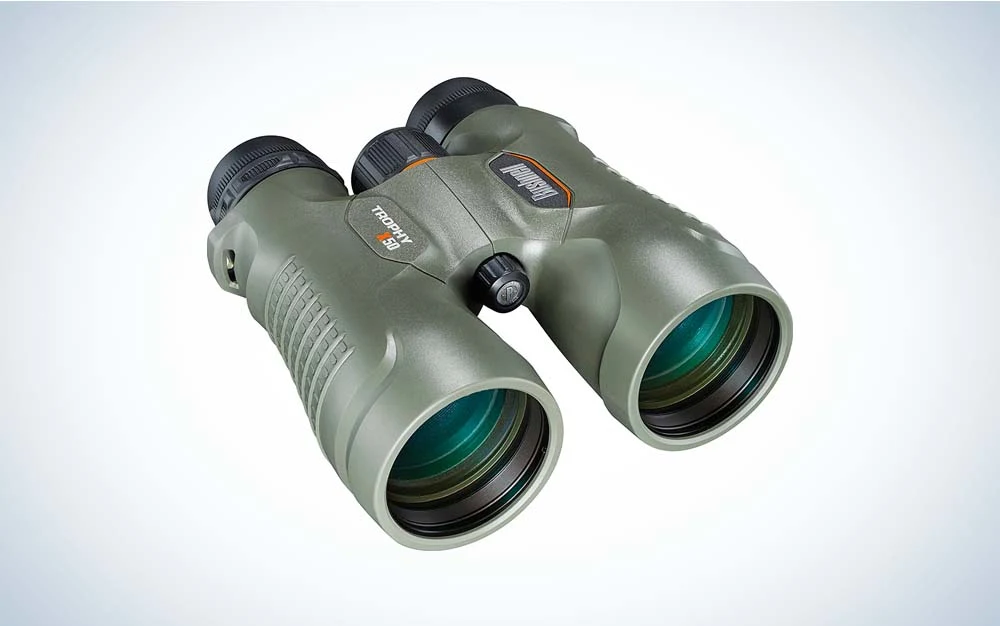
Specs
Weight: 25.3 ounces
Size: 6×5.25 inches
FOV at 1000 yards: 330 feet
Fully multicoated lenses
Non-phase-coated roof prism
Waterproof and fogproof (also comes in 10×50, 12×50, and 8×56)
I’ll make it easy for you: If you want to spend the absolute minimum on a roof-prism binocular that will get the job done, your choices from this list are the Bushnell Prime and the Trophy Xtreme. Which one to get boils down to your priorities. The Trophy has slightly better resolution and image quality. The Prime fares better in the worst weather, because it has the company’s excellent EXO Barrier and this one doesn’t. The Trophy has a much bolder look, which I don’t really care for, but you might.
One thing I will say for the Trophy: it’s tough. I’ve hunted with it a bunch, and one year at the SHOT Show, we tested the Trophy’s durability by running over it with a Chevy Suburban. It took four or five passes before there was any significant damage to the binocular.
Maven C1 10×42
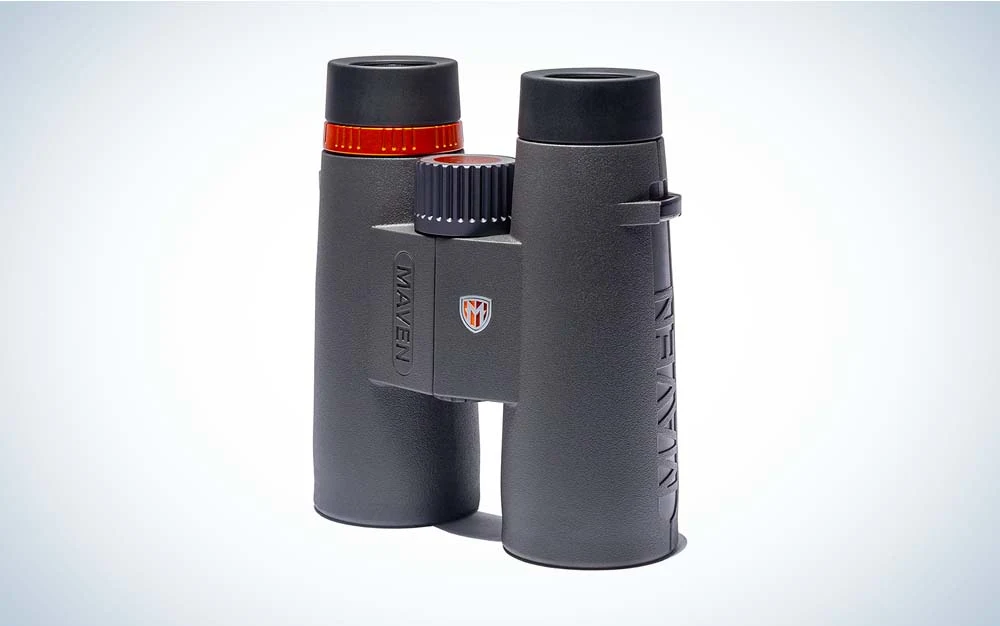
Specs
Weight: 24.5 ounces
Size: 5.7×5 inches
FOV at 1000 yards: 314 feet
Fully multicoated lenses, ED glass
Phase-and-dielectric coated roof prism
Waterproof and fogproof (comes in seven configurations)
The Maven C1 also just squeaks under our $350 street-price limit, and you get a lot for your money here too. Like several of the others on this list that are on the higher end of our low threshold, the C1 is a step up in terms of build quality, finish, and ergonomics. They feel great in the hand, and the adjustments are smooth and positive. The C1 finished middle-of-the-pack in the weather test, fogging and icing over at points, but it survived with no ill-effects. The image is bright with good contrast and only a small amount of noticeable field curvature and flaring at the edges.
Where the C1 really shines, though, is resolution, as it tied with the Nikon Monarch 5 for top honors in that test category among roof-prism models. If your top priority is pulling fine detail from the center of the image, you won’t be disappointed.
Types of Binoculars
Porro-Prism Binoculars
The world’s worst binoculars, the sort you get for free with a paid subscription, tend to be porro-prisms. So, they have a reputation for very low quality. And because of the way they’re constructed, porros are bulkier than roof-prisms of the same power and objective-lens diameter. But, there are a handful of porro-prism binoculars suitable for hunting whose optical quality is stunningly good for the price—better than some roof-prisms costing three times as much. Build-quality is often a bit lacking, but the price is rock-bottom. We’re talking less than $100 in some cases.
If you are on a very strict budget and you don’t mind either a little extra bulk or a smaller objective-lens configuration, these porros represent the best deal in hunting binos.
Roof Prism
The majority of hunting binoculars are roof-prism models. They have a better overall reputation for quality, and they are slimmer and more compact than porros of the same configuration, making them more comfortable to carry and use. If you really want the larger objective-lens diameter of a full-size binocular (which aids in low-light performance) and you plan to carry them a lot in the field, then it makes a lot of sense to go with a roof-prism. All of the test models here are full-size, either 10×42 or 10×50.
What Are the Best Cheap Binoculars?
We recommend any of the cheap binoculars on this list. They all have their own selling points, whether it’s crystal clear glass, a rugged waterproof exterior, or a budget-friendly price (as low as under $100). The Nikon Aculon A11 really won out, though, especially in terms of image resolution.
A few words of caution, however: There are some terrible, no-good cheap binoculars out there. Binoculars you wouldn’t give to your kid’s most annoying friend, let alone take hunting. But none of them are on this list. Also, if you are an optics snob (and there’s nothing wrong with that), you’re going to notice more visual artifacts, like chromatic aberration (which causes color shifts and color fringing), field curvature (which causes distortion along the image’s edges), and stray light (which causes flaring along the edges), with lower-end binoculars. This really bothers some people; others hardly notice it. So, make sure you can try and return any binocular before you buy.
Why Trust Us
For more than 125 years, Field & Stream has been providing readers with honest and authentic coverage of outdoor gear. Our writers and editors eat, sleep, and breathe the outdoors, and that passion comes through in our product reviews. You can count on F&S to keep you up to date on the best new gear. And when we write about a product—whether it’s a bass lure or a backpack—we cover the good and the bad, so you know exactly what to expect before you decide to make a purchase.


